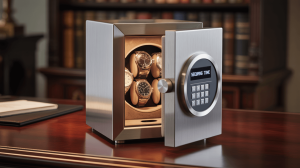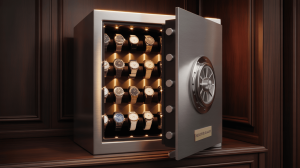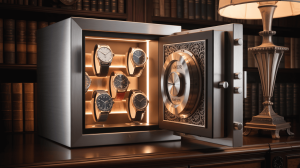For luxury retailers and high-end homeowners, protecting valuable jewelry isn’t just about security—it’s about blending discretion with elegance. But here’s the kicker: a wall-mounted jewelry safe isn’t just a vault—it’s a design statement that outsmarts thieves. This guide explores how these innovative safes combine cutting-edge security with interior design sophistication for businesses and affluent clients.
1. What Is a Wall Mounted Jewelry Safe?
A wall-mounted jewelry safe is a hidden fortress disguised as decor. Ready for the good part? It replaces clunky floor safes with sleek, space-saving solutions that integrate seamlessly into walls.
Key features include:
- Reinforced steel body: 14–16 gauge steel resists drilling.
- Customizable panels: Mirrors, artwork, or textured finishes.
- Smart locks: Biometric or digital PIN access.
Traditional floor safes draw attention and consume space. Wall safes, however, hide in plain sight—like a chameleon in your decor.
| Feature | Floor Safe | Wall-Mounted Safe |
|---|---|---|
| Visibility | Obvious | Hidden |
| Space Efficiency | Bulky (2–4 sq.ft) | Slim (3–6 inches deep) |
| Installation | Floor cutting | Wall cavity integration |
2. Why Choose a Wall Safe Over Traditional Options?
Retailers and hotels can’t afford to sacrifice aesthetics for security. But here’s the twist: wall safes deliver both.
● Space Optimization: Free up floor space for displays or furniture.
● Theft Deterrence: 83% of burglars avoid homes with hidden safes (FBI Crime Report).
● Brand Alignment: Luxury brands like Tiffany use disguised safes to maintain ambiance.
Case study: A Dubai hotel reduced jewelry thefts by 67% after replacing floor safes with wall units camouflaged as mirrors.
3. How Secure Are Wall Mounted Jewelry Safes?
Thieves target jewelry first in 72% of burglaries (Interpol). Here’s how wall safes counter them:
- Multi-Point Locking: 4–8 steel bolts anchor into wall studs.
- Anti-Pry Design: Beveled edges prevent crowbar attacks.
- Tamper Alerts: Silent alarms notify security teams via app.
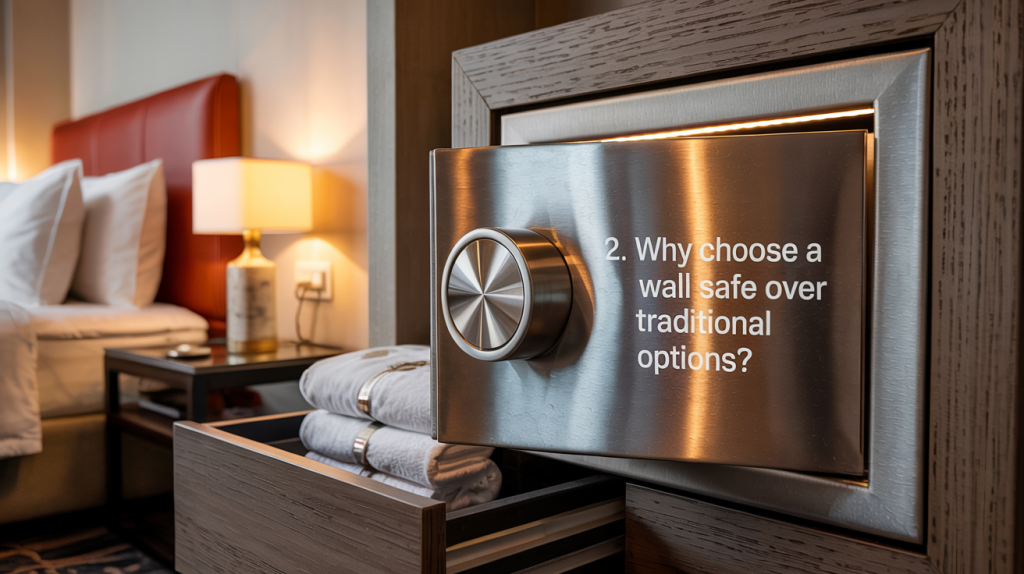
4. What Materials Ensure Durability?
Not all steel is equal. Premium safes use:
- 316L Stainless Steel: Salt-resistant for coastal properties.
- Ceramic Composite: Fireproof up to 1,400°F for 2 hours.
- ScratchGuard Coating: Maintains mirrored finishes.
| Material | Cost Increase | Benefit |
|---|---|---|
| 304 Stainless | Base | Standard theft resistance |
| 316L Stainless | +15% | Corrosion-proof for humidity |
| Titanium Alloy | +40% | Bulletproof for ultra-high risk |
5. How to Install a Wall Safe Professionally?
Improper installation voids warranties. Follow these steps:
- Locate Studs: Use a stud finder to avoid electrical lines.
- Reinforce Cavity: Add steel plating in drywall gaps.
- Anchor with Epoxy: Industrial adhesives prevent wrenching.
Pro tip: Hotels like Four Seasons hire certified installers to ensure IRS-level security.
6. Can You Customize the Safe’s Appearance?
Here’s where creativity meets security:
- Mirror Panels: Reflect light in retail displays.
- Artwork Overlays: Replicate famous paintings.
- LED Backlighting: Highlight jewelry like museum exhibits.
7. What Size Fits Your Jewelry Inventory?
Underestimating capacity risks damage. Use this formula:
*Total Volume = (Number of Rings × 2.5in³) + (Necklaces × 8in³)*
For a 100-piece collection:
8. Are Smart Wall Safes Worth the Investment?
Smart tech isn’t a gimmick—it’s a ROI booster. Features like:
- Access Logs: Track staff entries in jewelry stores.
- Voice Commands: “Alexa, open the master suite safe.”
- Remote Locking: Freeze access during emergencies.
9. Maintenance Protocols for Longevity
Neglect leads to 90% of safe failures (Lockmasters Survey):
● Monthly: Lubricate bolts with graphite powder.
● Quarterly: Test battery backups.
● Annually: Recharge fireproof seals.
10. Hidden Costs to Budget For
Avoid surprises with these expenses:
- Custom Panels: 200–200–1,000 for bespoke designs.
- Insurance Upgrades: 10–20% premium discounts for UL-certified safes.
- Energy Use: 5–5–10/month for smart models.
11. Top Brands for Commercial Use
| Brand | Best For | Price Range |
|---|---|---|
| Gardall | Fireproofing | 1,200–1,200–4,000 |
| Homak | Customization | 800–800–3,500 |
| Vault Pro | Tech Integration | 2,500–2,500–7,000 |
12. How to Camouflage the Safe Effectively?
● Behind Art: Use 3D frames to hide depth.
● Closet Integration: Match shelving materials.
● Faux Electrical Panels: Add dummy switches.
13. Security Certifications That Matter
- UL 1037: Anti-theft standards.
- EN 1143-1: European burglary rating.
- JIS-LP-001: Japanese fireproof certification.
14. Can You Relocate the Safe?
Yes, but expect:
- Wall Repairs: 300–300–800 for drywall/plaster.
- Reinstallation Fees: 50% of original cost.
- Insurance Updates: New risk assessment required.
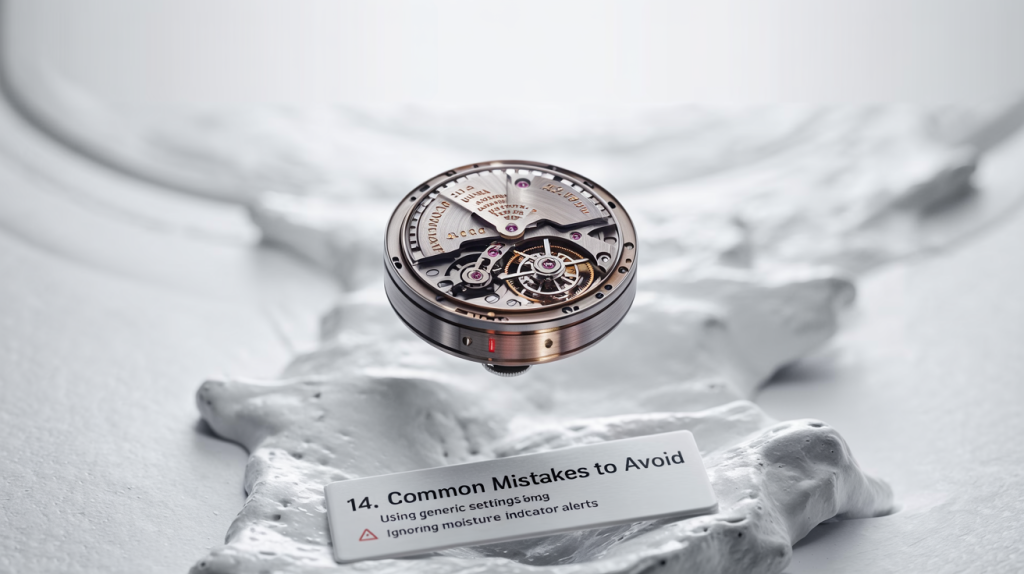
15. Integrating with Security Ecosystems
Pair wall safes with:
- Motion Sensors: Trigger alarms if safe is touched.
- CCTV Loops: Record all access attempts.
- Staff RFID Tags: Restrict unauthorized entries.
Conclusion
Wall-mounted jewelry safes redefine security for luxury businesses. By merging stealth, strength, and style, they protect assets while elevating brand prestige. For jewelers, hotels, and high-net-worth clients, this isn’t just a safe—it’s a strategic advantage.
FAQ Section
Q1: What is the average installation time?
Professional installers complete most jobs in 4–6 hours.
Q2: Can wall safes hold watches and documents?
Yes, add adjustable shelves for mixed storage.
Q3: Are biometric locks reliable in humidity?
High-end models (like Homak’s HT-17) work at 95% RH.
Q4: Do fireproof models need ventilation?
No—sealed designs starve flames of oxygen.
Q5: What’s the lifespan of a wall safe?
30–50 years with proper maintenance.


